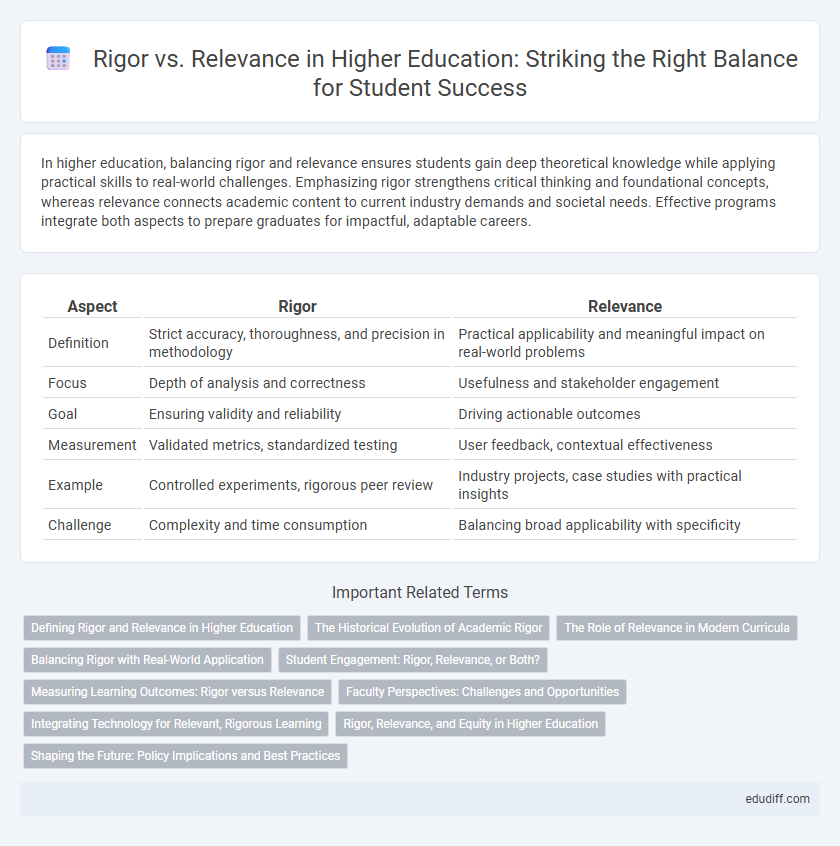In higher education, balancing rigor and relevance ensures students gain deep theoretical knowledge while applying practical skills to real-world challenges. Emphasizing rigor strengthens critical thinking and foundational concepts, whereas relevance connects academic content to current industry demands and societal needs. Effective programs integrate both aspects to prepare graduates for impactful, adaptable careers.
Table of Comparison
| Aspect | Rigor | Relevance |
|---|---|---|
| Definition | Strict accuracy, thoroughness, and precision in methodology | Practical applicability and meaningful impact on real-world problems |
| Focus | Depth of analysis and correctness | Usefulness and stakeholder engagement |
| Goal | Ensuring validity and reliability | Driving actionable outcomes |
| Measurement | Validated metrics, standardized testing | User feedback, contextual effectiveness |
| Example | Controlled experiments, rigorous peer review | Industry projects, case studies with practical insights |
| Challenge | Complexity and time consumption | Balancing broad applicability with specificity |
Defining Rigor and Relevance in Higher Education
Rigor in higher education involves challenging academic standards that promote critical thinking, deep understanding, and mastery of complex concepts, fostering intellectual discipline. Relevance emphasizes aligning curriculum and learning outcomes with real-world applications, workforce demands, and societal needs to ensure practical value and student engagement. Balancing rigor and relevance equips students with both theoretical knowledge and actionable skills crucial for career readiness and lifelong learning.
The Historical Evolution of Academic Rigor
Academic rigor has evolved historically from rote memorization and strict adherence to classical curricula towards incorporating critical thinking and real-world application. Early education models emphasized rigid discipline and knowledge recall, while contemporary frameworks integrate relevance by connecting content to practical, interdisciplinary challenges. This evolution reflects shifts in pedagogical theories that balance cognitive demand with meaningful engagement to prepare students for complex, dynamic environments.
The Role of Relevance in Modern Curricula
Relevance in modern curricula ensures learning experiences connect directly to students' real-world applications, enhancing engagement and retention. Integrating authentic tasks and current societal challenges aligns academic rigor with practical skills, preparing learners for complex problem-solving in diverse contexts. Emphasizing relevance fosters critical thinking and adaptability, key competencies in today's rapidly evolving global landscape.
Balancing Rigor with Real-World Application
Balancing rigor with real-world application in higher education demands integrating theoretical frameworks with practical experiences that enhance critical thinking and problem-solving skills. Courses designed with high cognitive rigor challenge students to engage deeply with content while applying knowledge to authentic scenarios, fostering transferable competencies essential for career readiness. This balance promotes academic excellence and ensures graduates adapt effectively to complex, evolving professional environments.
Student Engagement: Rigor, Relevance, or Both?
Student engagement thrives when learning activities are both rigorous and relevant, challenging students intellectually while connecting content to real-world applications. High rigor encourages critical thinking and deep understanding, whereas relevance enhances motivation by making lessons meaningful and applicable. Integrating rigor with relevance cultivates an engaging environment that prepares students for academic success and practical problem-solving.
Measuring Learning Outcomes: Rigor versus Relevance
Measuring learning outcomes requires balancing rigor, which emphasizes critical thinking and complex problem-solving, with relevance that ensures practical application in real-world contexts. High rigor challenges students to master discipline-specific skills and conceptual understanding, while relevance connects learning to authentic experiences, enhancing retention and motivation. Effective assessment strategies integrate both elements to prepare learners for academic success and meaningful career readiness.
Faculty Perspectives: Challenges and Opportunities
Faculty perspectives on rigor versus relevance highlight the challenge of balancing deep theoretical knowledge with practical application to enhance student engagement and learning outcomes. Many educators grapple with integrating real-world problems into rigorous curricula while maintaining academic standards that prepare students for advanced study and professional success. Opportunities arise in developing interdisciplinary approaches and experiential learning models that bridge the gap between conceptual rigor and practical relevance, fostering critical thinking and adaptability.
Integrating Technology for Relevant, Rigorous Learning
Integrating technology in higher education enhances rigor by facilitating complex problem-solving and critical thinking through advanced simulations and data analysis tools. Technology-driven platforms provide relevant, real-world applications that connect academic concepts to industry practices, ensuring learners develop applicable skills. Combining rigorous content with interactive digital resources fosters deeper engagement and prepares students for dynamic professional environments.
Rigor, Relevance, and Equity in Higher Education
Rigor in higher education ensures academic standards challenge students to develop critical thinking and advanced skills necessary for complex problem-solving. Relevance aligns curricula with real-world applications and labor market demands, fostering student engagement and career readiness. Equity guarantees all students, regardless of background, have access to rigorous and relevant learning opportunities, promoting inclusive success and reducing achievement gaps.
Shaping the Future: Policy Implications and Best Practices
Balancing rigor and relevance in education shapes future-ready policies by emphasizing critical thinking and practical application to foster student success. Policymakers must implement evidence-based curricula that integrate real-world challenges while maintaining academic standards to enhance learner engagement and outcomes. Best practices include continuous professional development for educators and adaptive assessment methods aligning with dynamic workforce demands.
Rigor vs Relevance Infographic

 edudiff.com
edudiff.com